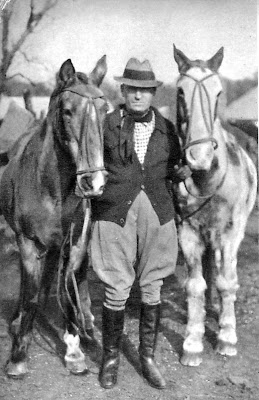In loving memory of Dr. Armando Lago.

Swiss long rider, Aimé Tschiffely, and his two criollo horses Mancha and Gato, made a legendary 10,000 mile ride from Buenos Aires to Washington, which took them through the mountains and jungles of South and Central America.
When in 1925, Tshiffely said he was going to ride 10,000 miles from Buenos Aires to Washington DC critics told him it was an impossible and absurd idea. Even more considering that the 29-year old Swiss had no prior equestrian knowledge and that he attemped to complete his task with two elderly horses, Mancha y Gato, aged 15 and 16, owned by Patagonian indians that were unbroken and running free on the Argentine Pampas. In Tschiffely's own words: "they were the wildest of the wild".
But Tschiffely, an amateur historian who left home at an ealy age and was teaching in a posh school for boys outside Buenos Aires, was not discouraged and set out to prove that the Criollo horse was the hardiest horse alive. He wrote, “The Criollos are the descendants of a few horses brought to Argentina in 1535 by Don Pedro Mendoza, the founder of Buenos Aires. These animals were the finest Spanish stock, at that time the best in Europe, with an admixture of Arab and Barb blood. That they were the finest horses in America is borne out by history and tradition.”
On the night before his departure, the intrepid horseman recalled that suddenly the carping of his critics and his own inexperience caused him “to be assailed by a sickly feeling, as if my stomach were a vacuum.” But, he wrote, “eventually there was only one thing to do: screw up my courage, burn all the bridges behind me, and start a new life, no matter whither it might lead.
Photo taken on January 1929 in the Argentine Rural Society.
The ride took the trio more then three years to complete, as they crossed the plains of Argentina, the desserts of Bolivia, the Andes, the jungles of Peru, Ecuador and Colombia, the Panama Channel, Mexico, the Mississippi and the Blue Ridge Mountains.
Along the way, the relationship between Tschiffely and his half-wild horses developped into a camradeship. Gato has an instinct for avoiding bogs, quicksands and deadly mud-holes; Mancha was always alert, an excellent watchdog, who distrusted strangers and would let no-one but Tschiffely ride him.
Upon the completion of their journey, Jimmy Walker, the Mayor of New York, greeted Mancha and presented Tschiffely with the New York City medal. During the Second World War Tschiffely visited Argentina. This photograph shows the last time he was with his old friends, Gato and Mancha.
Mancha and Gato were pensioned off to an estancia in the south of Argentina. Tschiffely’s book, “Southern Cross to Pole Star,” is considered the most important equestrian travel book of the 20th century. Since its publication in 1933, it has inspired countless equestrian travelers.
Gato died first, at the age of 32 in 1944. This picture shows Mancha at Gato's grave. Mancha was 37 when he died in 1947. Both horses are buried on Emilio Solanet's ranch, El Cardal. Silver and black leather keyring with a horse head design.
Silver and black leather keyring with a horse head design. Gold and brown breaded silver medallion with a horse head design.
Gold and brown breaded silver medallion with a horse head design.












































